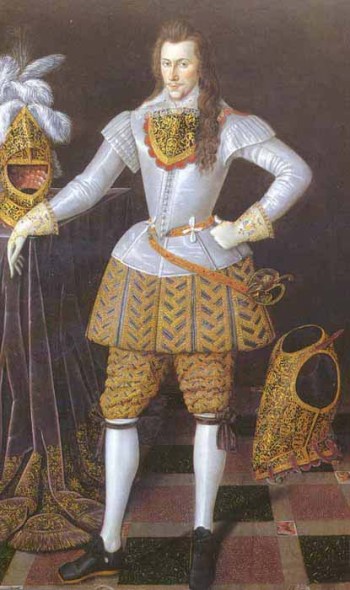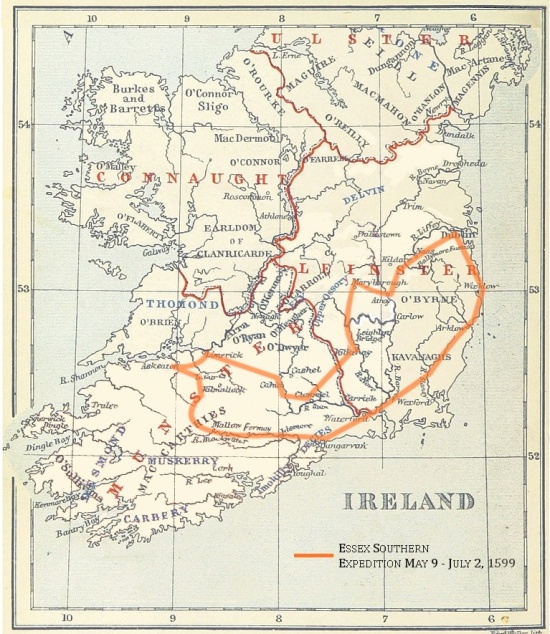
My uncle Gib oft swore that our Earl had in him all that was needful to do Queen Puss good service, had she the wit to see it.
“Which,” sayt my uncle, “she hath not.”
I, being young and saucie, sayt I feared His Harryship’s head held more hair than brains.
But my old uncle spake true.
No sooner had Linkin told me that our Earl was to lose his place as General of the Horse than there was supper talk in our household of his brave actions.

He probably wore the armour , or some of it, in Ireland.
Now in the Leeds Armoury, the full suit – 3/4 length – comes to just below the knee. He’d have worn riding boots with it.
The soldiers that went south with Essex were beset on all sides by rebels. Even so, they captured a rebel castle [Cahir] that some swore was inexpugnable [impregnable] because it stood on an iland in the midst of a river.
They brought relief to many towns and garrisons. Then, worn and weary, they turned for Dublin.
Linkin and I heared the master say that when our army travels they form a long line, like unto a snake.
’Twas no wonder to us that the rebels loved to attack this snake. The snake was moving eastward when a force of rebels came out of the trees. Essex and His Harryship were in as great a danger as any that day.
Essex – as is his wont – was in all places where the fights were. As was His Harryship, ever readie to lead his horses against the rebels where he could.
He chased them off, but his friend Sir Harry Daffers [Danvers], endeavoring to save some stragglers at the tail, was shot in the face. The ball lodged by his left ear, but ’twas sayt he was not much hurt by it.
Worse came when our weary soldiers were nigh to the safe town of Arklow. After chasing off more rebels who’d attacked them whiles they were crossing a river, our men came to better ground by the sea. Some hasted on ahead while others lagged behind.

South-west to Maryborough, then via Kilkenny, Clonmell and Cahir Castle to Limerick and Askeaton before moving cross-country to Dungarvon, then through Waterford and Arklow to Dublin.
The master and our mistress began to move cups and spoons around on the table. Linkin and I sat swivel-eared beneath. Then we guessed they did this to show the master’s kits what happened next.
The snake (we eared the clink of spoons) was moving along the shore. The sea was on one side. A bog (signified by a linen kerchief) and hills (cups) were on the other.
The Earl of Essex, ascending a hill to watch how all fared, saw a great body of rebels making ready to attack our spoons line. There were poor horses in that line, bringing the baggage, with scant soldiers to protect them.
They stood mazed to see hundreds coming at them.
Essex sent for the fightsome horses that were guarding the tail end of the line to make haste forward.
And he commanded His Harryship and the few horses with him to save the baggage horses and all from being cut to pieces. So they placed theirselves between them and the rebels.
The rebels came screeching across the bog. Then they saw Essex with some soldiers making ready to attack them at their side. They turned on him.
That left His Harryship with no choice but to quit the shore and ride fast and furious into the bog. By then more bold horses had joined him so he, with 24 in all, chased those rebels back into the woods.
When he returned to the line, he saw 3 heroick horses had come to grief, so he went back into the bog. Rabbit Fur-None [Robert Vernon], brother to His Harryship’s Puss [Bess], was trapped beneath his horse. Another man was dead, and one was sore wounded.
“How is it,” arrkst one of the master’s kits, “that the rebels may go across the bogs, but our men cannot?”
The master sayt that the rebels – being men of that country – knew where the ground was firm and where they must not tread.
Linkin sayt to me, “Our Earl may have saved the day, but when he comes to Dublin he’ll receive word that he’s lost his place as General of the Horse.”
I sayt, “’Tis well our Earl loves tennis. For Queen Puss likes to toss him to and fro and brickwall him like a tennis ball.”
 Tricks is understandably confused by talk of horse (cavalry), and regards the horses as full participants in the action.
Tricks is understandably confused by talk of horse (cavalry), and regards the horses as full participants in the action.
Accounts of the fight near Arklow differ, but there’s general agreement that the Earl of Southampton and the men with him distinguished themselves.
So much so that Henry Cuffe, one of Essex’s secretaries in Ireland, wrote to Edward Reynolds (the secretary in England coordinating reports) apologising because three men who were part of the “very brave charge…under the leading of my Lord of Southampton” had missed their mention in dispatches.
Henry Cuffe said he’d copied his account from another document after midnight and inadvertently skipped an entire line. He asked Edward Reynolds, who was responsible for receiving and coordinating reports, to make the necessary corrections.
I’m afraid I would have deserted my post if I had to get duded up like His Harryship. I mean….what did the enemy think? “Oh heavens, Cecil, here comes that English fop again. Don’t you just love his purple riding boots?” Truly, were they going into battle or to a fashion parade?
LikeLiked by 2 people
Oh, Larry, you are unkind. In the portrait, the Earl is kitted out in the height of cool Elizabethan dude fashion, but he would have looked a great deal plainer and scruffier at war. Apart from the decoration on his armour, of course.
Though I must admit that I’m rather taken with the idea of his boots being purple.
LikeLiked by 1 person
HaHa, something about purple boots that will make any man stand out in a crowd.
LikeLiked by 1 person
The Irish were probably demoralised by the very thought of them.
LikeLiked by 1 person
Good for His Harryship!
LikeLiked by 1 person
The armour is amazing. Much as I like to imagine a whole army dressed like that (including the purple boots), it’s very much the armour of a wealthy man.It must have taken forever to etch and then paint those designs.
Sometimes I too think that the earl’s head holds more hair than brains, but this is not one of those occasions.
LikeLiked by 1 person
When I first saw the armour in the portrait, I assumed it was his tilting armour, not field armour. The Leeds Armoury gives it a date of 1600, but says it was made in France, so he must have bought it when he was there in 1598 (and complaining of being broke).
It’s comparatively light, but I wonder how much of it he wore of it in Ireland – given the constant risk of getting literally bogged down. I assume the horse would have tried to keep themselves as light as possible. When the troops were on the move the horse seem to have spent a lot of time racing around trying to either draw the attacking rebels onto firm ground, or drive them back into the bogs and woods.
LikeLiked by 1 person
I looked up some similar armour in the Wallace Collection. It’s really light. The book says that they wore different bits depending on the situation.
LikeLiked by 1 person
That makes sense.
LikeLiked by 1 person
I must say whether watching Historical flicks or searching through History books – One would never think that bloodshed could be so cruel or deferment to survivors with su h Fashionable looks of soldiers and their Generals.. 😎🥀
LikeLiked by 1 person
That’s true! On one hand people can look so extraordinarily refined and elegant, and their art and poetry show they were very sensitive to human suffering, but violence and cruelty were never far away.
LikeLike
The rebels harried the Earl, and the Earl Harry’d the rebels!
LikeLiked by 1 person
Well said 🙂
LikeLiked by 1 person
I rather like the idea of the horses having full participation… can you imagine how different history would have been if that’d been the case? As for that armour… !!
LikeLiked by 1 person
The armour’s very stylish. It must have cost a small fortune.
LikeLiked by 1 person
I can only imagine what the Irish thought of him… Probably thought he looked like a horse’s arse in those purple boots. 🐎 Fascinated by O’Connor Sligo. I guess that was the dominant family name. There are some Maguires in our family.
LikeLiked by 1 person
I guess that branch of the O’Connors tacked Sligo onto the end of their name because they controlled the area. The names on the map are fascinating. I have O’Connor ancestors, but they emigrated to NZ from a district near Tralee – much further south.
LikeLiked by 1 person
My Nana’s maiden name was Pinkman and we thought they were secretly Jewish. We came to that conclusion because of dark curly hair and a love of musical instruments… It turns out that the family changed their name to be hidden from the English. Maguire (our original name) in Gaelic means ruddy faced man (Pinkman). What did we do?????
LikeLiked by 1 person
Ironic that his Harryship was doing brave stuff while nasty put-downs were still en route to him.
LikeLiked by 1 person
It is indeed. He must have been dismayed when he got back to Dublin and learnt what was in the letters.
LikeLike
That is putting it mildly!
LikeLiked by 1 person
Excellent! As always, I found the footnotes and the illustrations every bit as interesting as the main story!
LikeLiked by 1 person